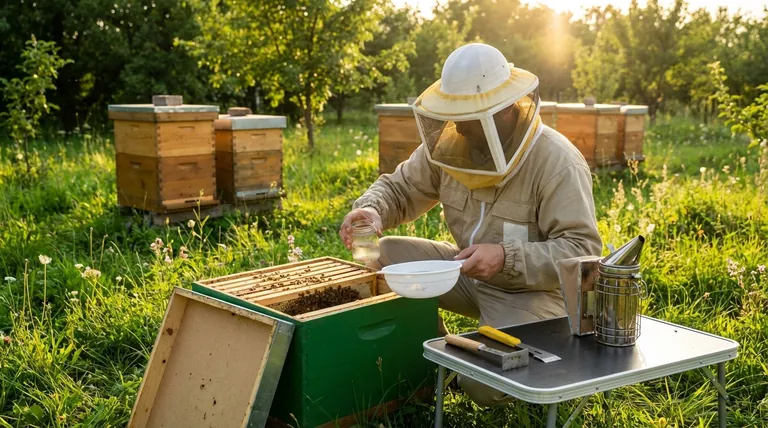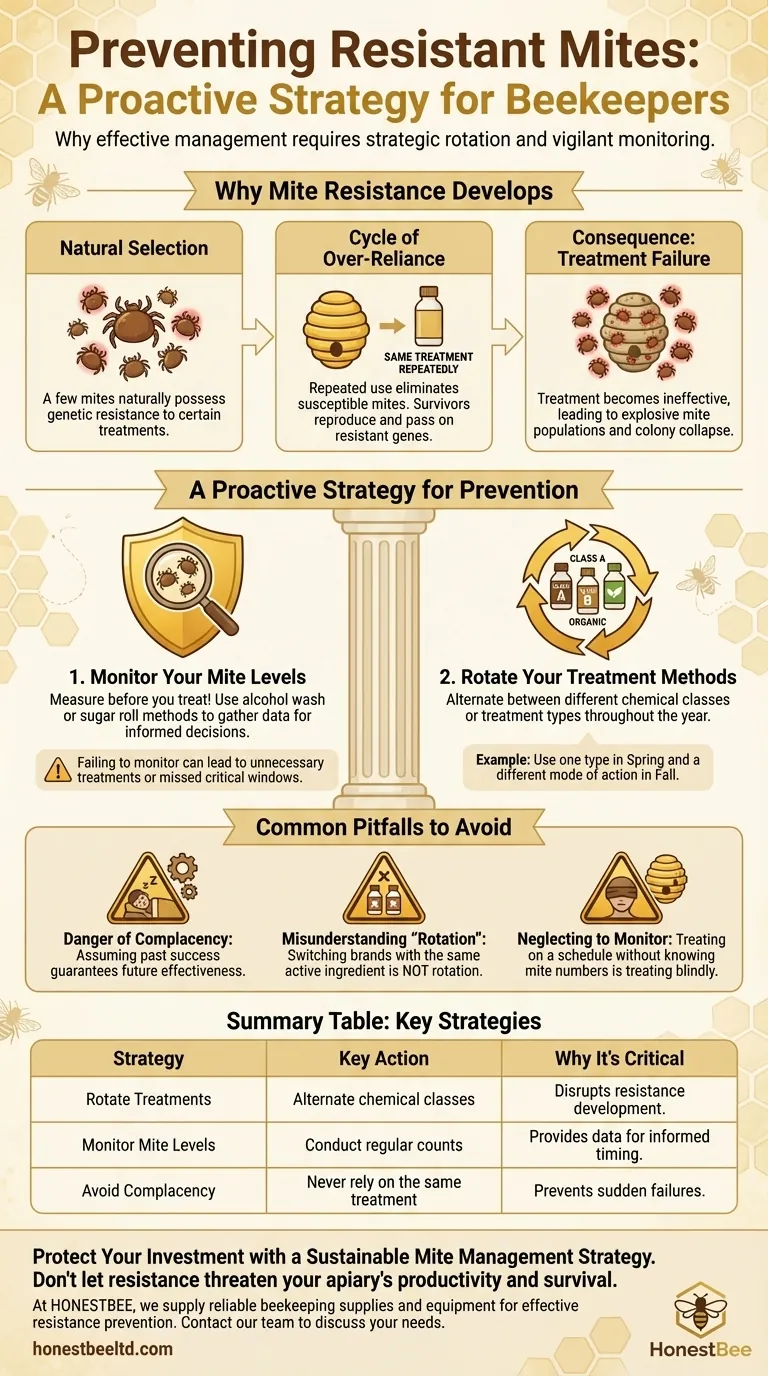To prevent resistant mites, the single most important strategy is to avoid relying on the same treatment method year after year. By rotating different types of treatments, you disrupt the mites' ability to develop and pass on genetic resistance to a specific chemical. This proactive approach is fundamental to long-term colony health.
Effective mite management is not just about killing mites today; it's about ensuring your treatments still work tomorrow. This requires a shift from simple chemical application to an integrated strategy of vigilant monitoring and strategic treatment rotation.

Why Mite Resistance Develops
Understanding the root cause of resistance is the first step toward preventing it. The problem is a straightforward, yet powerful, example of natural selection happening within your hive.
The Principle of Natural Selection
Within any large population of Varroa mites, a few individuals will naturally possess slight genetic variations that make them less susceptible to a particular chemical treatment.
The Cycle of Over-Reliance
When you use the same miticide repeatedly, you effectively eliminate the susceptible mites. However, the few naturally resistant mites survive the treatment.
These survivors then reproduce, passing their resistant genes to the next generation. Over several seasons, this process creates a mite population that is dominated by individuals who are no longer affected by your chosen treatment.
The Consequence: Treatment Failure
Eventually, the treatment that was once highly effective becomes useless. Beekeepers who fail to anticipate this are often caught by surprise when their mite counts explode, leading to weakened colonies that are highly susceptible to disease and collapse.
A Proactive Strategy for Prevention
A sustainable mite management plan is built on two core pillars: knowing your enemy's numbers and varying your method of attack.
Step 1: Monitor Your Mite Levels
Before you treat, you must measure. Regularly monitoring mite levels using methods like an alcohol wash or a sugar roll gives you the data needed to make informed decisions.
Failing to monitor is a critical error. It can lead to treating when it isn't necessary, exposing bees to needless chemicals, or worse, not treating when a colony is on the verge of being overwhelmed.
Step 2: Rotate Your Treatment Methods
Rotation is the central tactic for preventing resistance. This means alternating between different classes of miticides or treatment types throughout the year and from one year to the next.
For example, you might use one type of treatment in the spring and a completely different type of treatment (with a different mode of action) in the fall. This ensures that any mites resistant to the first treatment are likely to be eliminated by the second.
Common Pitfalls to Avoid
Adopting this strategy requires discipline and foresight. Simple mistakes can undermine your efforts and put your colonies at risk.
The Danger of Complacency
The biggest pitfall is assuming that because a treatment worked last year, it will work this year. Resistance can build quietly until it reaches a tipping point, resulting in a sudden and catastrophic treatment failure.
Misunderstanding "Rotation"
Simply switching between two different brand names is not true rotation if they use the same active ingredient or mode of action. You must ensure you are rotating between different chemical families or between synthetic and organic acid-based treatments.
Neglecting to Monitor
Treating on a fixed calendar schedule without knowing your actual mite load is treating blindly. Data from monitoring is the only way to confirm your treatments are working and to catch a developing resistance problem before it destroys your hives.
How to Apply This to Your Apiary
Your specific plan should be proactive and based on the long-term goal of sustainability, not just short-term mite control.
- If your primary focus is preventing colony loss: Make monitoring your number one priority. You cannot manage what you do not measure.
- If your primary focus is long-term treatment effectiveness: Create a multi-year plan that explicitly rotates between at least two, preferably three, different classes of mite treatments.
- If your primary focus is simplifying your routine: Establish a clear system that links monitoring results to specific treatment actions, removing guesswork from your beekeeping.
By thinking like a strategist and staying one step ahead of mite evolution, you can ensure the continued health and survival of your colonies.
Summary Table:
| Strategy | Key Action | Why It's Critical |
|---|---|---|
| Rotate Treatments | Alternate between different chemical classes or treatment types (e.g., synthetic, organic acids). | Disrupts the mites' ability to develop genetic resistance to a single treatment method. |
| Monitor Mite Levels | Conduct regular alcohol washes or sugar rolls to measure infestation levels. | Provides data to treat only when necessary and confirm treatment effectiveness. |
| Avoid Complacency | Never rely on the same treatment year after year, even if it was previously effective. | Prevents sudden, catastrophic treatment failure due to undetected resistance buildup. |
Protect Your Investment with a Sustainable Mite Management Strategy
Don't let resistant mites threaten your apiary's productivity and survival. A proactive, data-driven approach is essential for commercial beekeepers and distributors who depend on healthy colonies.
At HONESTBEE, we supply the reliable beekeeping supplies and equipment you need to implement an effective resistance prevention plan. From a variety of mite treatments to monitoring tools, our wholesale-focused operations ensure you have access to high-quality products.
Contact our team today to discuss your apiary's needs and build a long-term defense against Varroa mite resistance.
Visual Guide

Related Products
- Square Folding Bee Hat Veil with String for Beekeeping
- Long Langstroth Style Horizontal Top Bar Hive for Wholesale
- Cotton Folding Square Beekeeping Hat and Veil with Removable Mesh Bee-Proof Design
- Ventilated Adult Beekeeping Helmet Hat for Beekeepers
- Professional Insulated Winter Hive Wrap for Beekeeping
People Also Ask
- What features enhance the quality of the beekeeping veil? Choose the Right Protection for Your Apiary
- Why is protecting the head important in beekeeping? Essential Safety for Every Beekeeper
- How can beekeeping supplies and accessories enhance the hobby? Essential Tools for Safe & Rewarding Beekeeping
- How should the beekeeping hat veil be cleaned? The Only Safe Method to Preserve Protection
- What is the purpose of the high visibility veil on the beekeeping hat? Ensure Maximum Safety and Clarity



















